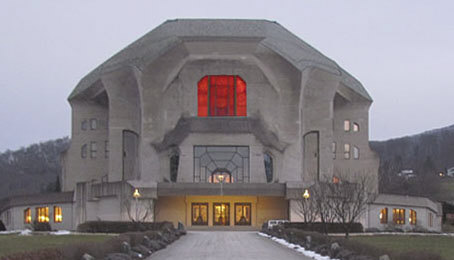In February, 2013, I stood and viewed the west front
of the Goetheanum and took this photo at right. This
building hovers over the walkway marked by Druid stones on each side. It was my introduction to the
Goetheanum(1) as Bradford Riley and I walked up to the building the first evening we arrived there.
Many books of Steiner lectures take great care to point out that the lectures were not intended for the
general public, but assumed some detailed knowledge of Steiner's works to comprehend fully what he
said. In addition, many of the lecture series come from notes, not seen nor edited by Steiner after the
lecture. Few of these editors have bothered to point out the good effect of lectures not see or edited for
publication by Steiner, but Thal-Jantzen does.
[page ix, Introduction] One advantage of this is that the tests have directness and give
a flavor of the mood of the time as experienced by his listeners. There is a strong sense
of purpose and mission running through all the lectures, such as his concern that the
visual arts should transform our consciousness and help build a vibrant new social
order.
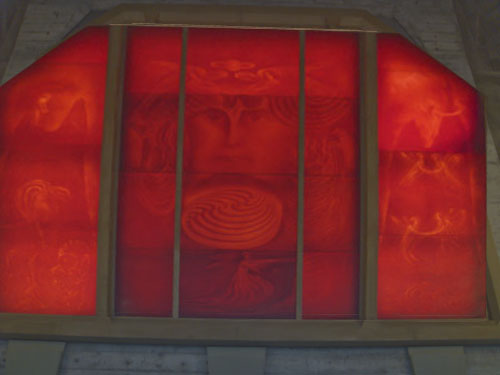
With the face of Mi-cha-el the Archangel looking to the West from the top floor of the Goetheanum
in the picture above, one can imagine that his body extends to the ground where his foot is holding down a
writhing dragon, snake, or demon and his right hand is raised, holding a sword, with which he is about to
dispatch the demon which represents the evils at large in the Western world today. One can only
understand the function of the Goetheanum rightly when one holds this Imagination.
[page xiii, Introduction] The Goetheanum building now standing on a hill at Dornach
is intended as a contribution towards the opposing of destructive forces being
unleashed within the human soul as the new millennium approaches.
The Goetheanum is Mi-cha-el's sword in our time. Instead of erecting a statue of Mi-cha-el showing
the Archangel doing the work of dispatching evil (as the Greeks might have done in a small temple), the
Goetheanum with its West-facing Mi-cha-el Window beckons us to come into its sanctuary as agents of
Mi-cha-el in our time, and to pick up our individual swords, and to do Mi-cha-el's work.
In our time most people believe that architecture is designed by the brains of human beings and that
inspiration is nothing but a fluke of neurons, neurotransmitters, and synapses. This is a blatant example of
retrodiction, a wonderful word which describes the process of making judgments about past events using
information from our present knowledge and abilities. This creates a great illusion when people try to
explain the origin of the pyramids of Egypt and the temples of Greece. Only by understanding the
evolution of human consciousness can we properly comprehend what was happening in the people who
built those monuments. They lived in concert with the gods on a daily basis and allowed the gods to work
through them. Thus, Homer began his epics thanking his Muse, a goddess who spoke to him the events of
which he wrote down for us to read today. He could not have been any clearer as to the origin of his words
when he wrote, "Sing, O Muse, of the anger of Achilles" to begin his Iliad. One needs to grasp deeply the
pervasive nature and effects of retrodiction in our modern way of thought for this next passage by Steiner
to make sense.
[page 3] In those days the gods let their forces stream into the unconscious or
subconscious life of human beings. So in a certain sense it is an illusion to believe that
in the minds or souls of the men who built the pyramids of Egypt, the temples of
Greece and other great monuments, only human thoughts were responsible for the
impulses and aims expressed in the forms, the colors and so on. In those time the gods
themselves were working through the hands, head and hearts of human beings.
Well, you might be thinking, why don't the gods inspire us this way today, are they less godly than
before? No, the correct answer is that we humans can operate more freely today than the ancient Egyptians
and Greeks; we possess a consciousness that permits us to tune our receivers to what the gods have to
offer us.
[page 4] The fourth post-Atlantean epoch now lies in the distant past and our age is
the first period of time in which the gods are putting the free creative activity of
human beings to the test. They do not actually withhold their help, but they vouchsafe
it only when human being out of their own individual soul, developed through a
number of incarnations, freely aspire to receive the forces streaming to them from
above. What we have to create is essentially new, in the sense that we must work with
forces which are altogether different from those obtaining in bygone times. We have
to create out of the free activity of our own human souls.
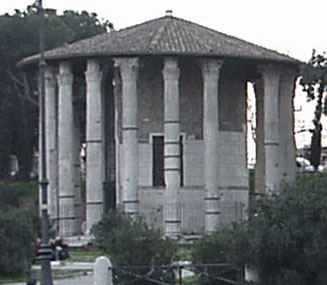
We have to create in full consciousness what humans of previous ages created unconsciously as the
gods worked through them on their ancient pyramids and temples. With their pyramids, the Egyptians
showed what they revered most: the physical body during the sentient soul age. They built these huge
monuments to place their dead pharaoh's body which was wrapped in protective layers to allow it passage
into the next world. With the advent of the intellectual soul age, the Greeks built temples which were
designed to be dedicated to a god with no humans inside of them. They were built to be viewed from afar,
like the Parthenon atop the highest point in Athens where it could be viewed from any place in the city and
surrounding area. When Christian churches were built with the advent
of the consciousness soul age, they were designed to enclose people
within them. The etymology of fane is helpful to understand the
transition from Greek to Christian churches as it means temple in the
Greek sense, the holy place suitable only for the gods of the temple,
no humans allowed. Humans remained outside the temple or pro-fane, which is the origin of our common word profane, which in its
origin meant outside the temple. In synagogues, the fane area is
behind a veil or curtain and can be entered only by the rabbi on one
day of the year, as I understand it. The congregation remains in the
pro-fane area. Similarly with Christian churches, there is an area, the
chancel, where the priest performs the consecration of the Host and
other duties and the parishioners remain outside that area, called only to its edge for communion. Since the
time of ancient Greece passed, the worshipers have been allowed into the new temples called churches but
there is still a fane area in the front of the church separated from the larger pro-fane area in the rest of the
church for the congregation.
The old Greek temples had no need for windows. Not understanding this, it seemed strange to me
when I first went to Rome to see a round ancient Greek temple too small to hold more than a few people
with no apparent doors or windows. With Christian churches the worshipers moved within the walls of a
temple, the size of the temple's space had to be increased, and doors and windows had to be added. The
Gothic church was a result of this evolution of churches into the consciousness soul age in which we
currently live.
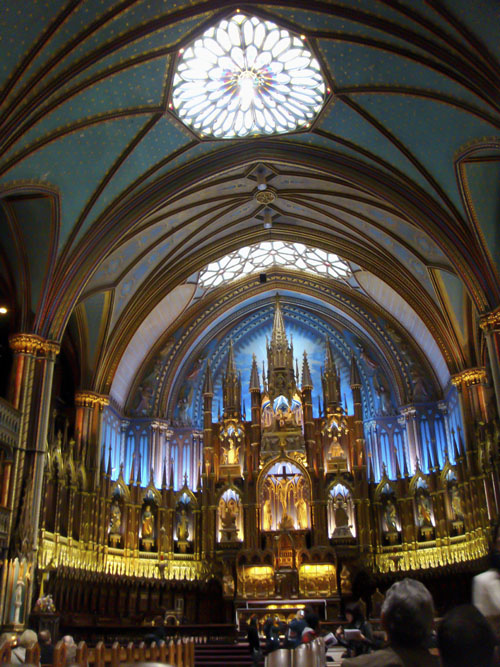
[page 7] A Gothic church, with its characteristic
forms, tries to express something that is not as
separate and complete in itself as a Greek temple.
In each and every form Gothic architecture seems
to reach out beyond its own boundaries, to express
the aspirations and searchings of those within its
walls; everywhere there is a kind of urge to break
through the enclosing walls and mingle with the
universe. The Gothic arch arose, of course, from a
feeling for dynamic proportion; but apart from this
there is something in all Gothic forms that seems to
lead out and beyond; they strive to make
themselves permeable. One of the reasons why a
Gothic building makes its wonderful impression is
that the many-colored windows provide such a
mysterious and yet such a natural link between the
interior space and the all-pervading light. Could
there be any sight in the world more radiant and
glorious than that of the light streaming in through
the stained-glass windows of a Gothic cathedral
among the dancing specks of dust?
From the Gothic cathedral we come forward into our time in which a new form of architecture is
required in which the walls themselves will seem to disappear.
[page 13] At every turn our eyes will light upon something that says to us: This
interior, with its language of colors and forms, in its whole living reality, is an
expression of the word spoken in this place, that most spiritual element which the
human being can enshrine within his physical body. The word that reveals the riddle
of the human being in wisdom and in prayer will be at one in this building, with the
forms that surround the interior space. The words sent forth into this space will set
their own range and boundaries, so that as they come up against the walls they will
find something to which they are so attuned that what has issued from the human
being will resound back into the space again. The dynamic power of the word will go
forth from the center to the periphery, and the interior space itself will then re-echo
the proclamation and message of the spirit. This interior will be enclosed and yet open
to infinitudes of spirit — though not by means of windows, but by its very shape and
form.
Steiner says later that our own age has not found the style of architecture suited to this age, up until
now. He said, "Architectural styles are indeed found, but only in the real sense when they are born out of
the overall spirit of an epoch." (Page 15) Clearly he meant for his Goetheanum to be the style suited for
the age we live in, but more importantly suited for the age of spiritual science which is coming soon. A
new age has this curious way of approaching us like the sky which is darkest before the dawn; the dawn
creeps up on us while voices everywhere are extolling the current age, not even aware of its darkness until
the light of the new dawn has evinced itself fully.
Over-analysis of creative works by critics and scholars is one way of extolling the darkness by
blotting out the first evidence of light, such as they did with Goethe's Faust. Such erudite criticism is like
doing autopsy without formaldehyde. The stench is unbearable to those who catch a whiff of the sweet
smell of the future.
[page 16] A stench of death is almost tangible when we have an edition of Goethe's
Faust before us peppered with the analytical footnotes of some scholar. How ought we
regard these things? I will try to make the point clear to you, very briefly, by means of
an example.
Steiner gives us the epic poem of The Seven Wise Masters on pages 16 to 18 which I recommend that
you read in its entirety. The step-mother of Diocletian poisons the mind of the Emperor against his son,
and Diocletian is saved through the advice of seven wise masters. Diocletian had the same problem as
humans do today, his soul had lost his natural powers of clairvoyance, but had developed an Ego which
could be instructed by the wise masters and finally be saved from his father's death sentence. Steiner
explains all this to us, but dislikes the process of explaining — why? That reminds me of a story.
Nasruddin was sitting at a table with his Master and there was a bowl with a rosy peach on it. Nasruddin
asks his Master to pass him the peach. The Master picks up the peach, eats it completely, enjoying every
bite, and then hands the peach pit to Nasruddin. Some of you will appreciate the story and some of you
will be puzzled. This next passage will help unravel the puzzle.
[page 18] We could continue thus, giving an absolutely correct interpretation which
would certainly be useful to our contemporaries. But what of our artistic sense? I do
not know whether what I now have to say will find an echo or not. When we read and
absorb such a book and then try to be clever, explaining it quite correctly, in the way
demanded by the modern age, we cannot help feeling that we have wronged it,
fundamentally wronged it. There is no getting away from the fact that a skeleton of
abstract concepts has been substituted for the world of art in all its living reality —
whether the explanation is true or false, illuminating or the reverse.
What is the pit of the peach but a skeleton of the luscious and nutritious peach? The Master was
teaching Nasruddin, as Steiner is teaching us, that when we ask for an explanation of any art-filled
creation, be it a story, a sculpture, a building, a piece of music, etc, we had better to have enjoyed and
digested it alone; consequently, we deserve to be given the bare pit after being forced to watch as a true
Master enjoyed the flesh of the peach. Nasruddin and I learned not to ask for explanations of Sufi stories
or artworks. They can stand alone, rightly understood. It is my joy to read and enjoy Sufi stories like this
one, and I recommend them to you.
For my part, I admit to creating a lot of pits during my early years of studying and reviewing Steiner's
works; these pits appeared as charts and graphs in my reviews. This was a process I learned during my
academic study of physics. They were helpful to me as a beginner and may be helpful to others, but in my
Steiner reviews they were like my offering of peach pits instead of the peach. In my reviews from now on,
I strive to produce new nourishment as I review Steiner's works, nourishment from my life, my world a
hundred years in Steiner's future, in the future he so often spoke of, when we humans have been further
spiritualized and enlightened. It is up to you, my Good Readers, whether I achieve this goal or not, but in
those cases where you deem yourselves as receiving only a pit from me, I apologize.
[page 19] When only our intellect is kept busy by spiritual science and we draw up
charts and coin all kinds of technical expressions, then spiritual science is nothing but
a skeleton — especially when it is speaking of the living human being.
Instead of charts and graphs, Steiner created artworks of sculpture, architecture, eurythmy (dance and
song together), and painting. His goal with the Goetheanum in Dornach was to embody anthroposophy in a
building which will stand through future ages as representative of the beginnings of spiritual science in our
age, just as the pyramids, Greek temples, and Gothic churches did in their time.
[page 48] If we mean to gain ground in the world for our movement, it is not enough
merely to show, on its own, the wisdom to be found in anthroposophy. In what we
create in Dornach we must take pains to embody, for the world to see, what is given to
us in the form of spiritual knowledge, just as older styles of architecture embodied
bygone cultures.
Imaginary lines of force in an electromagnetic field were postulated soon after Faraday made his first
electromagnetic motor. To this day, physicists pretend there are such lines of force, but they have found no
direct evidence of such lines, yet their presupposition that the lines of force exist stands today. The lines of
force Steiner was talking about are direct evidence of lines of force in the senses of human beings who
could feel them. I know physicists scorn evidence provided by human senses; that's their problem — let
them live or try to live with it. If you wish to be a full human being, you do best to accept the evidence
provided by all your senses, and to avoid unnecessary abstract logical concepts like imaginary lines of
force — physicists and engineers find them useful, but the rest of us can live as human beings without
them.
Steiner describes Earth and Sun shapes as felt by the ancients. The Earth shape is that of a dome,
"expressed by a shape that has a wide base and runs upwards to a point." The Sun shape was that of a
point with rays spraying upwards. The Sun shape resembled a palm and when the clairvoyant ability left
people without the knowledge of the Sun origin of the design, discussion began of what the design meant
and the palm leaf was chosen as an explanation. Steiner's famous statement that "when knowledge ends,
discussion begins" is illustrated here. The alteration of Sun and Earth designs around the Doric and Ionic
capitals began first and evolved over time into the Corinthian capital.
[page 63] You need only imagine the middle portion, which is merely indicated in the
Ionic capital, developing downwards to become the complete volute, and you have the
Corinthian capital. The middle portion is simply extended downwards, so that the
character of weight-bearing becomes complete. Then think of this weight-bearing in
the form of a sculpted figure, and you have the human force bent over in itself — the
ego bent over, bearing the weight.
Basically one of the convolutions of the middle of the Ionic capital bends over and becomes the
weight-bearing exactly like a human back, bent over like Atlas bearing the weight of the world on his
shoulders, becoming a Corinthian capital. Next the Sun and Earth motifs from the Doric capital appears
under each volute, not in painted form as before, but now in relief, in sculptured form. That is the leaf-like
structure often called the acanthus leaf, but in reality the resemblance only came in its final form and not in
its origin. This is another example of retrodiction by modern scholars who claim to be experts in
antiquities. Retrodiction is, rightly understood, a consequence of Steiner's dictum that "when knowledge
ends, discussion begins."
In these pages 53 to 66, Steiner outlines the results of his holding the unanswered question about the
acanthus leaf and sums up his findings in the passage below.
[page 66] Art in its essence can no more arise from an imitation of nature than music
can be created by imitating nature. Indeed even when art is imitative, the thing that is
imitated is fundamentally secondary, an accessory, and thus naturalism in itself is
absolutely contrary to true artistic feeling. If the shapes and forms in our art here are
thought by others to be grotesque, we will be able to draw comfort from the
knowledge that the artistic conceptions that find our art grotesque are those that see
in the acanthus motif nothing but a naturalistic imitation. In reality it is drawn from
the spirit and only in its later development came to bear a remote resemblance to the
acanthus leaf. Artistic comprehension in future ages will simply be unable to
understand this attitude of mind which in our time influences not only the art experts,
who are supposed to understand their subject, but which also dominates artistic
creation as such. The materialistic attitude of mind in Darwinism also confronts us in
artistic creation where there is a growing tendency to turn art into a mere imitation of
nature. Insight into the origin of the acanthus motif has given me much joy, for it
proves circumstantially that the primordial forms of artistic creation have also sprung
from the human soul and not from imitation of external phenomena.
It seems clear to me that the architecture of the Goetheanum could not have sprung from anyone with
a materialistic attitude of mind who imitated nature. Steiner puts it bluntly on page 67, "if you create on
the basis of concepts and ideas nothing of value will ensue." What is expressed artistically in Steiner's
architecture comes from his own spiritual underpinnings. Steiner's architecture is as different from so-called modern architecture as each new symphony of Beethoven was from his previous symphony.
The most important concept which helped me to understand the structure of the Goetheanum was
Steiner's description of a jelly mold, how the building was like a jelly mold turned upside-down and spirit-filled space remained where the jelly would be. See diagram from page 69.
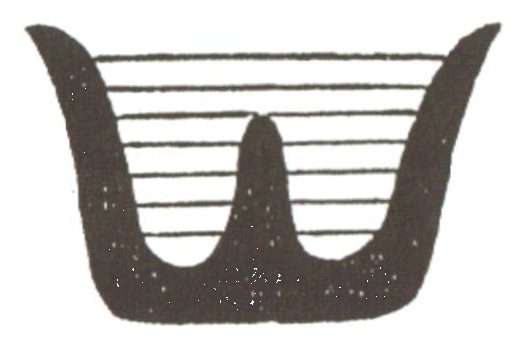
[page 69] The same principle may be applied in the case of the interior design of our
building, only here there is no jelly inside but the
living word of spiritual science moving and
weaving in the form possible for it. All that is
enclosed within the spatial shapes, all that is
spoken here and done within them, must adapt
to them as the jelly adapts to the negative forms
of the jelly-mold. We should feel the walls as the
living negative of the words that are spoken and
the deeds that are done in the building. That is
the principle of the interior design here. Think of
the living words of spiritual science as they come
up against these walls, hollowing them out in accordance with their profundity of
meaning. They hollow out shapes that fit their meaning. This is
why these interior forms are shaped as they are, worked out of the
flat surface.
Steiner and other workers carved into the flat woods in the original
Goetheanum to create the shapes out of the wood. One of the pleasures of
doing wood carving is to learn to love the surface you are creating and to
enjoy caressing the wooden surface as it evolves. Carving our native
Louisiana cypress was the most fun for me, and I include a photo of my
favorite wood sculptures from the 1960s, showing front and back views. I
could never consider doing wood sculpture with electric saws or chain saws;
even during the roughing in of the image I insisted on using only my hand
gouge and chisels. Plus, wood sculptures are meant to be touched and enjoyed
fully, not just looked upon. Steiner felt the same way.
[page 70] Here you should experience the form within yourself so that, holding the
gouge in a particular way, you grow to love the surface you are creating, the surface
that is coming into being here under your mallet and gouge. I must confess that I
cannot help caressing a surface like this once it has been created. We must grow to
love it, so that we live in it with inner feeling instead of thinking of it as something
that is merely there for our eye to look at.
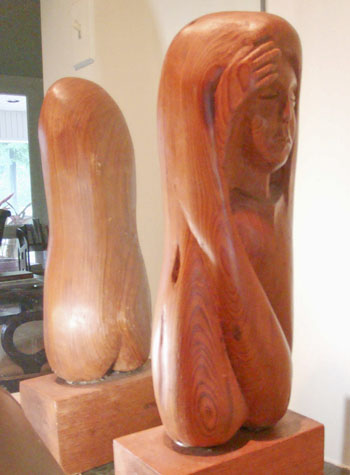
In my best wood sculptures, the subject came from an inspiration which arrived as I contemplated the
wooden piece I began with. I didn't think of it as clairvoyant vision at the time, but now I wonder if indeed
it wasn't because so much of my direction came from the feeling level that, as I began carving, the
Madonna figure above began to emerge from the cypress. If people understood the importance of feeling . .
.
[page 76, 77] They would realize that the development of clairvoyance leads human
beings to the realm that lies behind the world of the senses. They would also realize
that art is the divine child of clairvoyant vision — although it only lives as
unconscious feeling in the soul — and that the forms that are beheld by the
clairvoyant eye, in the higher worlds, cast their shadow pictures down to the physical
plane.
One can learn to understand these "unconscious feelings in the soul" by paying attention to "time
waves from the future" when they arrive. Some salient feeling appears for no conscious reason and can be
attributed to no cause at all. Quite possibly it will be ignored or else attributed to some physical thing at
hand. An example is the ring, which, when placed on my daughter's hand, gave her an incredible feeling.
As it turned out, that ring became her most special ring which is always on her hand in the almost ten years
since(3). This is a way that the spiritual world speaks to us, via feelings.
[page 96] We must learn to sense how the spiritual world speaks to us. When this has
become a living perception of what the soul must do if it is to find the way to those
regions from which the speech of the gods proceeds, we shall turn our eyes to where
the walls are pierced by the windows. There we shall be shown what lives in the
human being who consciously or unconsciously treads the path from the physical to
the spiritual world.
In our time people are interpreting spiritual meanings symbolically which for them means to do what
is done with the Corinthian capital, to see it a representation of something in the physical world of nature, the
acanthus leaf. Steiner is clear in his exhorting us to feel the forms of architecture as being alive in us.
When he tells us to "learn to sense how the spiritual world speaks to us", is it not clear that he is telling us
to learn to feel? It is in feeling that we hear the spiritual world speaking to us.
[page 101] The spirit lives, and hence it must be expressed in our building in a living
way, a truly living way. We shall not understand this any better if we
begin to interpret the spirit symbolically. The only way is to feel that the
forms are alive, that they are organs for what is spoken by the spiritual
world.
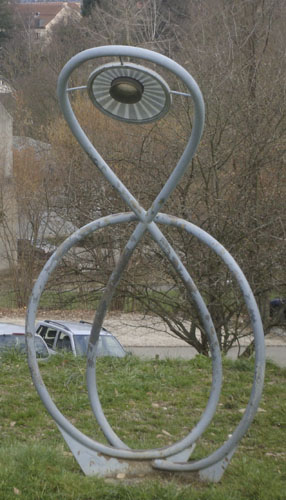
In pages 103 through 108 Steiner describes geometric figures in a unique
way that I had not encountered before. I could write the equations for the
circle, ellipse, hyperbola, but never understand what Steiner reveals about
them. The ellipse is a curve of addition — a new way of saying that the
length of the line drawn from each foci to other one after connecting with a
point on the ellipse remains constant. I had experienced standing on one foci
under an elliptical dome in the Washington, D. C., and could hear a whisper
spoken by someone at the other foci. All the sound from one foci is focused
on the other foci. This is also true of a circle which has only one focus, the
line simply goes to the circle and back to the same focus and is called the
radius. Next he showed how the hyperbola can be considered a curve of
subtraction. The lemniscate (usually portrayed as a figure 8 curve) is a curve
of multiplication. And amazingly, he shows how the circle is a curve of
division. "The circle is the same whether we say it is the simplest of all forms or that the product of
division from two points is always equal." (Page 108) He then points out that curves of the ellipse,
hyperbola and lemniscate can be found in and around the Goetheanum. (Page 109)
The ground plan of the first Goetheanum is that of two circles which seems to me to correspond to the
fane and profane areas as Steiner describes them. The profane circle connects with everyday life, and the
fane circle with the whole cosmos.
[page 109] There are two circles, but the one corresponds to the life of everyday while
the other is connected with the whole cosmos. We bear within us a lower self and a
higher self, yet both are one. Thus our building had to be a twofold structure. Its form
expresses the dual nature of man — not in any symbolical sense but because the form
is as it is. When the curtain in front of the stage is open we shall sense an image of the
human being not only as he is in everyday life, but as complete being. Because the
forms express a movement from west to east, they directly express the path of the
lower to the higher self.
Several more ideas arrive in Lecture Four, beginning with how Steiner relates the circulation in the
macrocosm of the Sun, Earth, and Moon to the circulation in the microcosm of our human body consisting
of the head, lungs, and heart. The diagram on page 121 of the major and minor circulatory paths is worth
pondering. The next idea is that "When we find something beautiful but do not quite know why,
something is taking place within our astral body." (Page 122) One might adjust the old adage to say,
"Beauty is in the astral body of the beholder." We also recall the famous saying, "Truth is beauty and
beauty truth" when we read the following passage about how we feel warm when we experience
something beautiful:
[page 122] The reason we feel this warmth is that if we were as conscious in our astral
body as we are in our ego we would at that moment experience a deep moment of
knowledge about the cosmos.
Cave paintings, large drawings across vast spaces on hillsides, etc, are all left by ancient peoples, and
we puzzle over their origin. What we call primitive art, rightly understood, is clairvoyant art because the
ancient people who created them had a native clairvoyance that humans have since lost(4). "People
experienced the content of their astral bodies as living movement." (Page 122) And they created art which
represented that felt movement. Steiner explains how animals adapt to the colors of their environment, not
by the survival of the fittest rules of Darwinian thinkers, but by absorbing the colors into themselves. The
long term effects can be seen in the whiteness of polar bears and the short terms effects in chameleons. We
humans do not absorb colors into our astral body as animals do; as a higher being we absorb colors into
our being in a spiritual sense. Thus it is, Steiner says, that "blue, for instance, becomes the expression of
rest, or red the expression of all that is passionate and fiery. Because we reach out with our ego beyond the
flowing sea of color, it is changed for us into flowing perception or feeling." (Page 127)
When we humans still had a native clairvoyance, the gods filled our thoughts and guided the motions
of our bodies and art came as naturally as breathing to us.
[page 129] When that was still the case a blaze of blue had met their gaze when they
approached the gods, so they had expressed it in blue. And when an enemy
approached, an alien being bearing down, red flared up. This was a direct experience,
so there was no need for imitation.
In Homer's Iliad we are privileged to read of the time shortly after humans lost their native
clairvoyance. In a short episode Hector dons his helmet to leave to go into battle, and his son Astyanax
cries in fright. What this reveals is that the young son, being nursed by his mother, can still see spiritual
realities and perceives that the red brush across the top of his father's helmet means danger, an enemy, and
reacts as if his father were an enemy. Were the ancient clairvoyance still present, the adults Greeks could
have seen the astral bodies in bright red hovering over Hector and the Trojans as they approached in anger
to do battle, and no brushes on the Trojan helmets would have been needed. The brushes were there to
simulate the angry astral bodies no longer visible to most men with the recent passing of the native
clairvoyance.
How do we know the clairvoyance recently passed? Homer's epics were available directly through
clairvoyant vision for hundreds of years before writing had been invented. With the passing of this vision
as a common human ability, those who could still access the spiritual world created a so-called oral
tradition and related the stories to other humans. It was during this period when writing came into being as
a tool to ensure that these stories would be available to future humans, such as us, who would not
otherwise have access to the spiritual realities of the stories. Thus it is plausible that Hector's helmet
would have the red brush on the top to frighten the Greek warriors, who otherwise would not have been
able to perceive the red flaring astral bodies of the Trojan warriors.
Today we are on the verge of returning to a knowledge of the spiritual world, with a conscious
clairvoyance, and it is important for us to realized that imitative art is no long apropos for the future we
are entering.
[page 130] Nowadays, however, we are living in an age when human beings must
again find their way into the spiritual world if there is to be a renewal of art. There
must be a transition from imitation to a true artistic creation. The imitative arts
reached their prime in the creations of Raphael and Michelangelo. Now, however, we
face a different challenge. We have to enter consciously into the spiritual world and
bring down the forms and colors living in the spiritual sea of the cosmos flowing all
around us. A beginning must be made. Something must be brought down from the
spiritual world that cannot be achieved by imitating what our senses perceive all
around us. I have already spoken about the extent to which this conception is flowing
into the forms of our building, and on another occasion we will consider this new
conception of art in painting. Today my endeavor was to deepen the feelings and
perceptions which must be ours if we are really to understand the transformation that
must come about before the old forms of art can pass over into new ones.
Much ado has been made about "horse whisperers"; people who seem to calm horses by whispering
into their ears. This process has led to much discussion, which word should perk up the ears of Good
Readers because it indicates that true knowledge of what is going on during "horse whispering" session
has been lost. The answer is simplicity in itself: horses are clairvoyant. What happens is horse whisperers
approach a horse with a calm astral body and the horse recognizes this and calms down. When the
whisperer says something the thoughts he is thinking as he whispers are perceived directly by the horse
who complies with the perceived request.
[page 137, 138] Without some degree of clairvoyance, a horse would no more see a
human being than human being without clairvoyance would see an angel, for human
begins simply do not exist for the horse as physical being, but only as spiritual beings.
It is only because the horse has a degree of clairvoyance that it can perceive human
beings standing above it rather like angels. What horses see in us is quite different
from what we see in them. Even for higher animals we are like ghosts. If animals
could speak — not in the way they are sometimes made to 'speak' nowadays, but in
their own language — we would soon see that it would never occur to them to see us
as resembling themselves, for they see us as higher, ghostly beings. We may see
human beings as creatures of flesh and blood, but animals certainly do not. To the
modern mind this of course sounds utterly nonsensical, which only goes to show how
far our present age is removed from the truth.
To horses we are like ghost riders! Many of the puzzling behaviors of animals and pets can only be
understood when these animals' clairvoyance abilities are taken into account. Many of the puzzling
behaviors of human beings today can be understood if we realize that ancient humans had clairvoyant
abilities which only our children under five years old possess today. We humans who once had an atavistic
clairvoyance, have access to the spiritual world through our astral bodies which reveal spiritual realities to
us through our feeling function, a function which is unconscious to most humans, up until now. To those
of you who earnestly study Rudolf Steiner's work and pay attention to your own feelings, a new world of
understanding can open up to you from now on.
Through the lectures and appendices, we have learned about the design of the original wooden
Goetheanum, its destruction in a disastrous fire in 1922, and the second Goetheanum — a structural
concrete architecture which was finished in 1928 and remains today as a vibrant center of anthroposophy
for the world. It is a pilgrimage point for anyone who studies anthroposophy. When there, one should read
aloud the meditation created by Rudolf Steiner for the laying of the Foundation Stone during the
Christmas Conference in 1923. During that conference, on the first anniversary of the burning down of the
first Goetheanum, Rudolf Steiner said that the physical Goetheanum was gone, but the spiritual one lives
on. We can say in a similar fashion that the physical Rudolf Steiner is gone, but the spiritual one lives on
in his written words, in his lectures, in his sculptures, in his paintings, in his eurythmy, in his Mystery
Dramas, and most of all in his architecture, especially his Goetheanum which stands high on a hill
overlooking the region, not as a Greek Temple, but as a gathering place where a new synthesis of the arts
can converge in one place and reach out from there to the ends of the Earth and the Cosmos itself.
---------------------------- Footnotes -----------------------------------------
Footnote 1.
Photo was edited to highlight the Mi-cha-el window, which was otherwise not lit from inside that evening.
Return to text directly before Footnote 1.
~~~~~~~~~~~~~~~~~~~~~~~~~~~~~~~~~~~~~~~~~~~~~~
Footnote 2.
What is the power of an unanswered question? This constitutes my Matherne's Rule #25 which you can explore deeper here.
Return to text directly before Footnote 2.
~~~~~~~~~~~~~~~~~~~~~~~~~~~~~~~~~~~~~~~~~~~~~~
Footnote 3.
This is written up in my Matherne's Rule No. 36 here.
Return to text directly before Footnote 3.
~~~~~~~~~~~~~~~~~~~~~~~~~~~~~~~~~~~~~~~~~~~~~~
Footnote 4.
For those who see in some of these ancient artworks evidence of UFOs, I offer to them Carl Jung's concept that the unidentified
object in UFO is the Self, which was certainly as unknown to ancients as it is to many otherwise erudite people today.
Return to text directly before Footnote 4.
~~~~~~~~~~~~~~~~~~~~~~~~~~~~~~~~~~~~~~~~~~~~~~
~^~
List of Steiner Reviews: Click Here!
Any questions about this review, Contact: Bobby Matherne
To Obtain your own Copy of this Reviewed Book, Click on SteinerBooks Logo below:


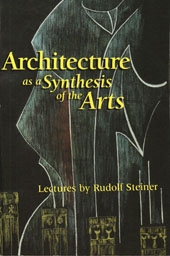 == == == == == == == == == == == == == == == ==
== == == == == == == == == == == == == == == ==
22+ Million Good Readers have Liked Us
22,454,155
as of November 7, 2019
Mo-to-Date Daily Ave 5,528
Readers
For Monthly DIGESTWORLD Email Reminder:
Subscribe! You'll Like Us, Too!
== == == == == == == == == == == == == == == ==
Click Left Photo for List of All ARJ2 Reviews Click Right Bookcover for Next Review in List
Did you Enjoy this Webpage?
Subscribe to the Good Mountain Press Digest: Click Here!


CLICK ON FLAGS TO OPEN OUR FIRST-AID KIT.
All the tools you need for a simple Speed Trace IN ONE PLACE. Do you feel like you're swimming against a strong current in your life? Are you fearful? Are you seeing red? Very angry? Anxious? Feel down or upset by everyday occurrences? Plagued by chronic discomforts like migraine headaches? Have seasickness on cruises? Have butterflies when you get up to speak? Learn to use this simple 21st Century memory technique. Remove these unwanted physical body states, and even more, without surgery, drugs, or psychotherapy, and best of all: without charge to you.
Simply CLICK AND OPEN the
FIRST-AID KIT.

Counselor? Visit the Counselor's Corner for Suggestions on Incorporating Doyletics in Your Work.

All material on this webpage Copyright 2019 by Bobby Matherne


